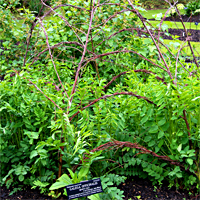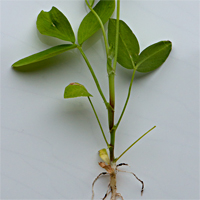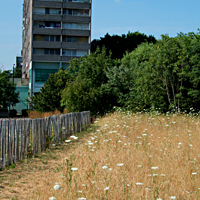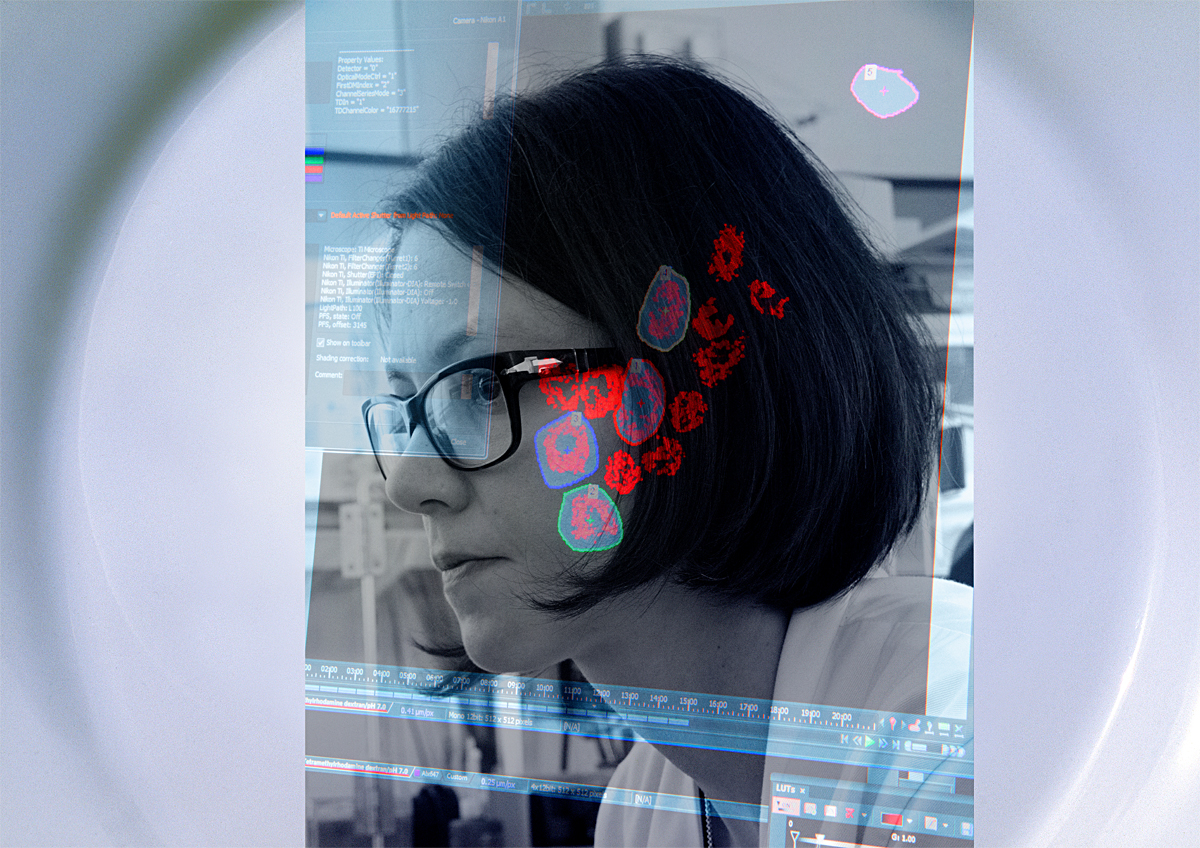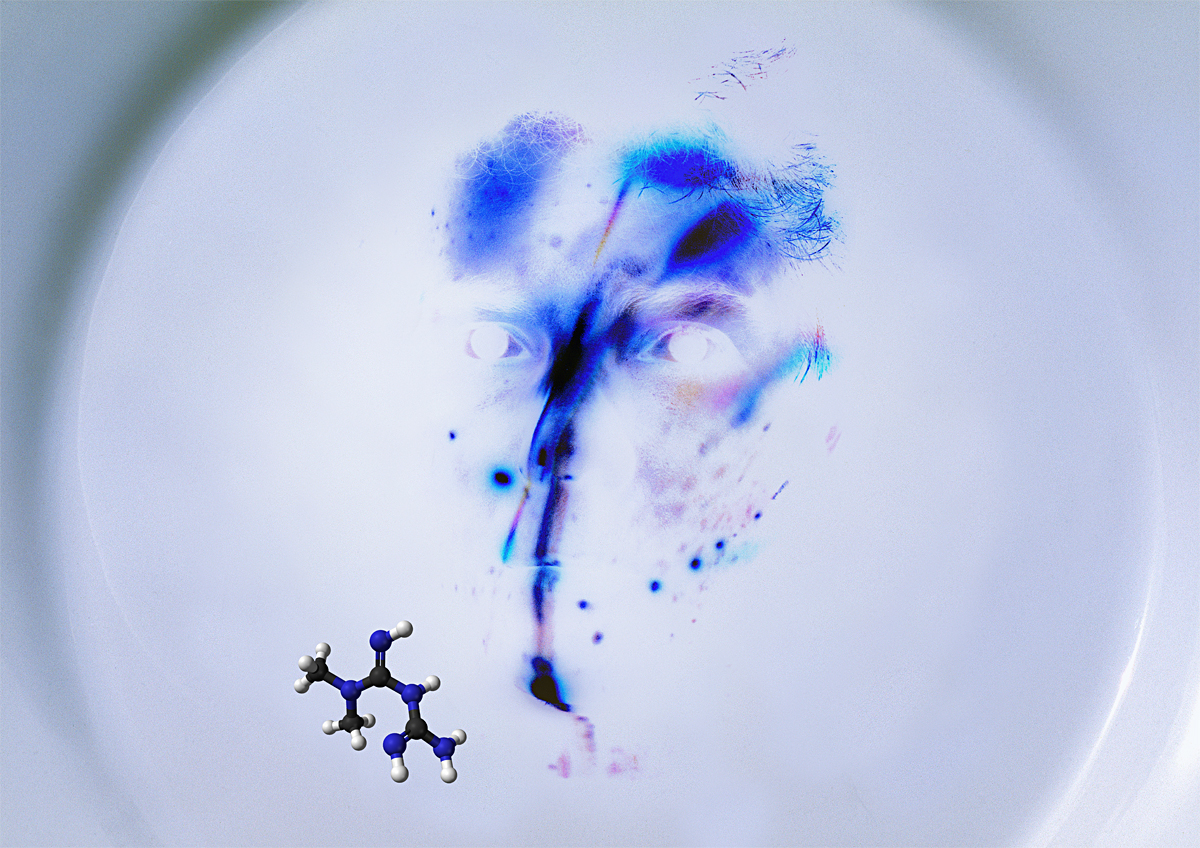about Galega and Metformin
The Fox Got You is an art and science project celebrating common plants at the origin of medicinal drugs (for an overview, go to the home page). Galega and Metformin is about the drug Metformin, which is derived from the plant goat's rue. This series started the project: Artist Françoise Sergy is diabetic and Metformin is one of her main medications. She wanted to celebrate a plant which in a quiet way is helping her stay alive.
Metformin acts by reducing the body’s resistance to insulin. The drug is known to affect mitochondria organelles, which are responsible for making the 'energy currency' used to drive all the processes of life. In the artwork you can see below, the artist has explored her experience of diabetes. She has also made connections between goat's rue and scientific images of mitochondria.
For this series, Françoise was based at the MRC Mitochondrial Biology Unit in Cambridge, Britain. You will find more information about the scientists' work and an explanation of the role of Complex I within mitochondria in the section Visits to Biomedical Research Laboratories.
about goat's rue
Goat’s rue is native to the Mediterranean region and naturalised in Europe. It was introduced in the 1800s in the USA as a forage crop, where it is now on the Federal Noxious Weed List because it is toxic to some domestic animals. Introduced in England in 1568, it is more common in the south of Britain but is gradually migrating northwards. It can be very dominant in some areas, particularly near and around motorways, where the large scale shifting of soil must have helped its seeds to spread. In the UK it is not usually considered a threat to native ecosystems.
The plant has several english names: Goat’s Rue, French Lilac, Spanish Sanfoin, Italian Fitch, False Indigo and Professor Weed. Its Latin name is Galega officinalis. The name Galega is derived from the Greek terms for milk (gala) and agein (to bring on), because it is believed to stimulate lactation in livestock. The word officinalis means "belonging to an officina", the store room of a monastery where in the Middle Ages medicines were kept.
Goat's rue scientific classification is: Order - Fabales, Family - Fabaceae (pea family), Subfamily - Papilionoideae, Genus - Galega, Species - officinalis.
The plant is used as an ornamental in gardens, also as a green manure crop, a bee plant and a herb in cheese making. There are some reports of toxicity to mammals, although it is fed to cows and goats to increase their milk yield.
It is a hardy herbaceous perennial, growing to a height of 1.5 M. In rich moist soil it can make large clumps. It grows in full sun or semi-shade. Flowers are either soft pink or white, appearing late June and July. In themselves, they are fairly small but each raceme has many flowers, which are pollinated by insects. Seed pods develop in August and the seeds look like tiny beans.
about the drug Metformin
The drug Metformin is currently the first line of treatment for type 2 diabetes. Its main action is to reduce insulin resistance within cells and to regulate glucose production by the liver. Scientists are still researching the drug’s precise mechanisms of action but it is known to affect several metabolic pathways, as well as energy production in mitochondria.
Metformin has been used as an anti-diabetic drug for over 50 years. During this time, many long-term studies on diabetes have shown that the drug has other positive effects: Diabetics treated with Metformin have a lower risk of cardiovascular diseases and strokes than those treated with other drugs. Their risk of developing certain cancers is also reduced. This has lead to a renewed interest in the drug - this small molecule which originally came from a plant is proving to be truly fascinating.
Diabetes was recognised as a condition as long ago as 1500 BC, when Hindu scholars described its main clinical features and the Egyptian medical Ebers Papyrus recommended certain treatments for it. Worldwide, more than 400 plant-based products have been recommended for diabetes over the centuries. One of the most important turned out to be the substance galegine, which comes from goat’s rue. In the 1920s several relatives of galegine were synthesised by chemists, including the group called biguanides, which Metformin belongs to. This was at the same time as insulin was being discovered. At this point it was argued that insulin was the best treatment for type 2 diabetes (a view no longer held by doctors) and research on the galegine drugs focused instead on their antimalerial properties. Later, Dr Jean Sterne, a French clinical pharmacologist, decided to focus once more on the drug's ability to lower blood glucose. He conducted rigorous research which lead to the commercial development of Metformin under its brand name 'Glucophage' (glucose eater) in 1957.
Glucophage was produced in France by a very small pharmaceutical company, Aron Laboratories, which promoted the product through direct contact with clinicians, free offers and word of mouth. It encouraged clinicians to do their own trials on its efficacy and to report the findings. This type of personalised marketing would be very much frowned upon today. Over the next few decades, studies trickled in, but it wasn't until the landmark UK Prospective Diabetes Study (1977 to 1997) that Metformin gained the positive reputation it enjoys today. In the study, overweight diabetics on Metformin lived longer and had fewer heart attacks than those with the same blood glucose levels achieved by using insulin or other drugs. Metformin not only is effective at controlling diabetes but it also helps to prevent some of its long term complications.
The drug has been used in Europe since the late 1950s. However, in the USA, the Food and Drug Administration only approved of the use of the brand name Glucophage in 1994 and the generic Metformin drug finally became available to Americans in 2002.
For a longer version of this article, please view the pdf file.



